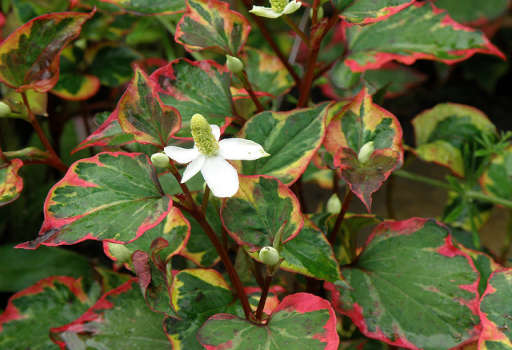Houttuynia Health Benefits, Properties, and Uses

Scientific Name: Houttuynia Cordata
Common Names: Lizard Tail, Chameleon Plant, Heartleaf, Fishwort, Bishop's Weed
Properties: Antibacterial, Antihistamine, Antioxidant, Anti-viral, Anti-allergenic
What is Houttuynia?
Houttuynia is a plant that also goes by its botanical name houttuynia cordata Thunb and Chinese name dokudami. It was first described by Swedish researcher Carl Peter Thunberg in 1784. Houttuynia grows natively in wet, warm parts of China as well as Nepal, India, Japan, Thailand and Indonesia. It was later introduced to Australia, New Zealand, North America and the Pacific Islands where it is often considered a weed.1 There are two types of houttuynia:1
- Japanese houttuynia has an orange scen
- Chinese houttuynia has a cilantro-like scent
Houttuynia is a creeping herb with heart-shaped leaves. The stems range in color from green to purplish red. Houttuynia produces small white flowers. It has long been coveted for its variety of houttuynia medicinal uses.1
Houttuynia Health Uses and Health Benefits
Houttuynia benefits are well known, which is why ancient Asian cultures used this herb for energy and vitality among other uses. Traditional Houttuynia medicinal uses have included being a treatment for respiratory conditions, inflammation, urinary tract infections and skin sores.1 2 Houttuynia benefits for health include:2 3
- Regulating blood sugar and offering anti-diabetic benefits
- Providing anti-histamine support
- Helping in weight loss
- Providing dieuretic effects
- Removing toxins from the body with antiviral and antibacterial benefits
- Improving respiratory conditions and fighting respiratory infections
- Boosting immune system and fighting against infection
- Inhibiting herpes virus
- Protecting against poisoning
Because of houttuynia benefits for respiratory conditions, researchers today are considering houttuynia medicinal uses for fighting against SARS (severe acute respiratory syndrome).2 4 Other important houttuynia medicinal uses for improved health and disease prevention include:
- Allergies - Houttuynia benefits include being a natural anti-histamine, which can help treat symptoms of seasonal allergies.
- Asthma - Houttuynia is linked to improved breathing function and can help treat asthma.
- Bronchitis - Houttuynia has natural antiviral and antibacterial properties that can help the body fight respiratory infections like bronchitis.
- Cough - Houttuynia can help boost the immune system, which allows the body to better fight off a cough.
- Gastritis - Houttuynia can support the digestive system by fighting off harmful bacteria and promoting the growth of healthy bacteria to prevent gastritis.
Houttuynia Side Effects and Precautions
There are no known houttuynia side effects. Be sure to consult a qualified naturopathic healthcare provider to ensure the correct dosages to prevent any houttuynia side effects.4